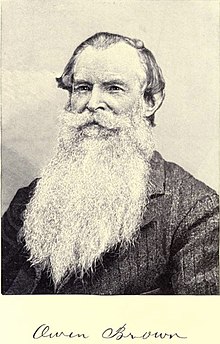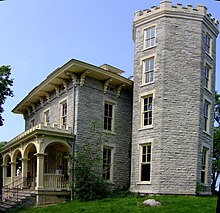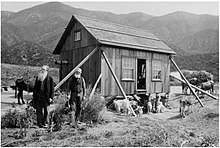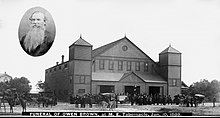Owen Brown (abolitionist, born 1824)
Owen Brown | |
|---|---|
 Brown in 1882 | |
| Born | November 4, 1824 Hudson, Ohio, U.S. |
| Died | January 8, 1889 (aged 64) Pasadena, California, U.S. |
| Resting place | A hilltop near Altadena, California, 34°13′3″N 118°9′37″W / 34.21750°N 118.16028°W |
| Known for | John Brown's raid on Harpers Ferry |
| Parent(s) | John Brown, Dianthe Lusk Brown |
| Relatives | Owen Brown (grandfather), brothers John Brown, Jr. and Jason, sister Annie Brown Adams; half-brother Watson, various other half-siblings |
Owen Brown (November 4, 1824, Hudson, Ohio – January 8, 1889, Pasadena, California), was the third son of abolitionist John Brown. He was "to some extent a cripple from childhood by an injury of the right arm";[1][2]:344 in 1862 he was described as "physically unfit for military service".[3] He described himself as "an engineer on the Underground Railroad" and a "woodsman almost all my life", by which he meant not that he was a lumberjack, but that he was capable at hiking through woody terrain.[2]:346 He never married. When asked later in life if he had been too busy to marry, his reply was: "Hardly; there are men who fix their affections on one, and losing that one remain single ever after."[4]
He was much affected by the death of his mother, along with his newborn brother Frederick, when he was eight.
General comments[]
Of John Brown's six sons, he was said to be the one that most resembled his father physically;[5][4] he was "exactly like the portraits of his father".[6] He was described thus in the 1859 warrant for his arrest:
Owen Brown is thirty-three or thirty-four years of age, about six feet in height, with fair complexion, though somewhat freckled—has red hair, and very heavy whiskers of the same color. He is a spare man, with regular features, and has deep blue eyes.[7]:549
He was also said to most resemble his father psychologically:
There was in Owen Brown, it is said[,] much of that excess of zeal, which is called sometimes eccentricity and sometimes fanaticism, and which was the characteristic of John Brown of Ossawatomie. Like his father, he was perfectly inflexible in carrying out what he had determined upon, and his courage was absolutely dauntless. He was renowned among his acquaintances for his passion for exact justice, and was honored by them for his sterling uprightness and integrity.[8]
Another reporter said that Owen, of John Brown's sons, "is perhaps the greatest character of them all. Noticeably eccentric, with a strange mingling of gentleness and roughness, sentiment and course practicability [sic], which even his intimate friends cannot understand, with one of the warmest of hearts and the readiest hand, he leads a wandering kind of life, seeming to cut himself off from old friends and associations, and yet after a while returning to them, or letting them know by some kind message that they are not forgotten. He seems literally a man without a home, for realizing his restless disposition he has never married or formed any ties that could not easily be shaken off. He resembles his father in form and feature, and also—though in an exaggerated degree—his independence of the world's opinion."[9]
Abolitionist activities[]
Kansas[]
Owen fought with his father in Kansas and was present at the sack of Lawrence. Border ruffians from Missouri burned his house and stole his cattle. He participated, along with brother-in-law Henry Thompson, in the Pottawatomie massacre.[10]:18 "He was imprisoned, ill-treated, and finally driven from the State, for the sole reason that he was an abolitionist."[11] In 1888 he recalled some of his Kansas activities.[12]
Harpers Ferry[]
Owen, as he told it later, before the raid "spent many months in the mountains of the South, searching out suitable places for the rendezvous and concealment of liberty-seeking slaves". During the three months becore the raid, his father, under cover of prospecting for minerals, examined and approved of a number of them.[13]
Owen participated in his father's raid on Harpers Ferry in 1859. He was guarding weapons at the Kennedy Farm, in Maryland, and did not enter Harpers Ferry itself. When the raid failed he escaped capture and underwent what has been called "the most difficult and tedious flight that ever occurred in this country".[13] After weeks of hiding and travelling at night, living on uncooked corn taken from fields and nearly starving, his shoes having given out,[13] he arrived at Crawford County, Pennsylvania, where he had lived as a child (see John Brown (abolitionist)#Time in Pennsylvania). There he was fed and helped recuperate by a Quaker who remembered his father.[13][14] Now near the Ohio border, he reached the safety of the home of his brother John Jr., at that time in Ashtabula County, Ohio, some 300 miles (480 km) from Harpers Ferry.[2]
In early February Owen was indicted by a Virginia grand jury for "conspiring with slaves to create an insurrection".[15] On March 8, 1860, the new governor of Virginia, John Letcher, announced a $500 reward (equivalent to $14,402 in 2020) for his apprehension and delivery to Virginia. The Attorney General of Ohio, Republican Christopher Wolcott, refused to honor Virginia's request for Owen's arrest.[7]:554–555 Owen remained in Ohio for many years.
Owen was the last surviving member of the raiding party; his older brothers John Jr. and Jason did not participate, and his full sister Annie Brown Adams outlived him, but was sent home from the Kennedy farm before the raid.
Put-in-Bay, Ohio[]

Owen was "not at all eager" to tell the story of his participation in his father's raid. A reporter had to make many visits to get him to tell the story of his difficult escape, which he said he had never told in 12 years.[2]:344 At that time (1871) he and his older brother John Jr. were farming at Put-in-Bay, Ohio, Owen in a "one-roomed shanty", full of mementos, near his brother's house.[2][16] He spent the winter months alone, except for a dog, as a hermit on neighboring Gibraltar Island, caretaker for the summer home of Ohio financier Jay Cooke.[13][4][17] To pass time, he learned shorthand from books and copied the Bible in shorthand twice.[13] He remained there until about 1885.[13]
Pasadena, California[]



In the early 1880s—different sources give different years—Owen moved to Pasadena, California, joining his brother Jason, sister Ruth, a teacher, and her husband Henry Thompson, who were already there.[19] They were seeking to escape "the increasingly negative broad popular memory of Brown." Pasadena, however, was sympathetic to the memory of John Brown; it was a Republican city, settled by immigrants from Indiana.[10]:22 Owen, Jason, and to a lesser extent Ruth were considered to be "important figures", the men "eccentric and charming".[10]:25
According to an obituary:
About five years ago [1884] Jason and Owen Brown took a homestead on a bench of mountain land five or six miles north of Pasadena, at the settlement now called Las Casitas. This they subsequently sold and took land higher up the mountain side, built a cabin, cleared and worked a few acres, and li[v]ed there—two feeble old men, alone. ...They were much visited by tourists and citizens, some from mere curiosity and others from a warm sympathy with the historic career of the family. They had made a good wagon trail up to their mountain hermitage, and were continuing it as a donkey path to the top of the mountain known as Brown's Peak, but it is not completed yet. Owen had a desire to be buried on the top of Brown's Peak; and if Jason ever succeeds in finishing the trail he will try to have his brother's grave up there as he desired.[20]
Their mountain cabin was only a mile from the house of Ruth Brown Thompson, his sister, and her husband, in Pasadena.[21]
Jason wrote, in an 1886 letter, "The people of Pasadena are eastern, mostly, and are very kind to us; they raised over $100, a short time ago without our knowing it, and gave it to us to buy a cow."[22] When John Jr. visited them (see picture at right) they had to sell the cow to get money for John Jr.'s return east.[23]
There, they were celebrated and supported, not for helping their father end slavery, but for a more contemporary movement, temperance.[10] Owen became "one of the best known of Pasadena's early residents."[19] The two "feeble old men", as an obituaey described them, were "much visited by tourists and the curious".[24]:4 An as-yet unidentified photographer carried his equipment up the mountain on several occasions, and left us good pictures of both cabins, including the second one seen from above.
Temperance[]
Owen believed that what he called "the rum power" was a bigger evil than slavery, "and he gave himself to its destruction with the same devotion, and the same love that he gave to liberty".[25] Celebrating the contemporary temperance campaign was a means to avoid dealing with their father's radical egalitarianism and recourse to violence.[10]:30 Owen and Jason were honorary members of the Women's Christian Temperance Union.[26]
An obituary noted that he sent "fruit and sympathy" to the anarchists on trial in the Haymarket affair.[27] At the time of his death Owen was living with his sister Ruth in addition to brother Jason.[28]:53
Funeral and grave marker[]


Owen died of pneumonia January 8, 1889, at the home of his sister Ruth Brown Townsend, in Pasadena, California, at the age of 64.
January 10 was called by a newspaper "a historic day for Pasadena".[20] His funeral, led by a Quaker,[28] was the largest ever held in Pasadena; at least 1,800 people attended.[11][25][29] The city trustees attended as a body, as did students from the Pasadena Academy.[20] Six pallbearers, including John Hunt Painter, had known John Brown in Massachusetts, Iowa, or Kansas.[28][20] A photographer was there. "John Brown's Body" was sung.[24]:4
A marching band escorted the 2,000 mourners, nearly the entire population of Pasadena, in the funeral procession up to Little Roundtop Hill in West Altadena in the Meadows (34°12′58″N 118°09′41″W / 34.216199°N 118.161381°W).[30] Owen had asked to be buried on the hilltop near his cabin,[19] in a spot called sublime, "on one of the highest peaks of the Sierra Madre mountains, commanding a view of the valley below for 60 miles (97 km), the sea and even the islands of the sea."[31]
Grave marker[]
Ten years later, a marker was placed at the grave site.[32][33] It read: "Owen Brown, Son of John Brown, the Liberator, died Jan. 9, 1889." Two iron ornaments, a heavy hook on the left, and a 6" diameter ring on the right, were attached to eyelets in the marker and could be moved—symbolizing freedom from the shackles of slavery and rapture from mortal bounds. 200 people attended the dedication.[34]
The marker disappeared from the grave site in 2002, along with the concrete base and surrounding rail fencing, after the property on which it was located was sold.[35] No legal action was taken, as the person or persons responsible have never been identified. In 2012, the missing gravestone was found a few hundred feet from the gravesite.[36][37] In 2021, it was announced that the gravestone would be reinstalled.[38]
In popular culture[]
He is the narrator, an old man living in California, in Russell Banks' novel about John Brown, Cloudsplitter.
Owen Brown is a supporting character in Ann Rinaldi’s novel Mine Eyes Have Seen. The book is from the perspective of Owen’s sister, Annie Brown.
Actor Jeffrey Hunter portrayed Owen in the 1955 film Seven Angry Men. The title refers to John Brown and his six grown sons, focusing mostly on the moral debate between Owen and his father.
He is portrayed by actor Beau Knapp in the 2020 Showtime limited series The Good Lord Bird, based on the 2013 novel of the same name by James McBride.
Archival material[]
Some letters of Brown are held at the Oregon Historical Society Research Library, Portland, Oregon.
See also[]
References[]
- ^ "History of John Brown otherwise "Old B," and his Family". Charleston Daily Courier (Charleston, South Carolina). October 22, 1859. p. 1. Archived from the original on November 16, 2020. Retrieved November 14, 2020 – via newspapers.com.
- ^ Jump up to: a b c d e Keeler, Ralph (March 1874). "Owen Brown's Escape From Harper's Ferry". Atlantic Monthly: 342–365. Archived from the original on 2020-11-07. Retrieved 2020-10-19.
- ^ "Personal". The New York Times. September 28, 1862. p. 5. Archived from the original on July 23, 2021. Retrieved July 23, 2021 – via newspapers.com.
- ^ Jump up to: a b c "Notes and excerpts". Oakland Tribune (Oakland, California). July 25, 1877. p. 2. Archived from the original on July 20, 2021. Retrieved July 18, 2021 – via newspapers.com.
- ^ "John Brown's Raiders". (Salina, Kansas). January 16, 1873. Archived from the original on 2021-08-06. Retrieved 2021-05-27 – via Chronicling America.
- ^ "John Brown's Sons. Leading the Quiet Life of Ohio Farmers on an Island of Lake Erie". Daily Alta California (San Francisco, California). 23 Oct 1882. p. 4. Archived from the original on 26 August 2021. Retrieved 26 August 2021 – via California Digital Newspaper Collection.
- ^ Jump up to: a b Hinton, Richard J. (1894). John Brown and his men; with some account of the roads they traveled to reach Harper's Ferry, by Richard J. Hinton. Boston: Funk & Wagnalls. Archived from the original on May 25, 2021. Retrieved January 25, 2021.
- ^ "Owen Brown". (Iola, Kansas). January 25, 1889. p. 4. Archived from the original on 2021-08-06. Retrieved 2021-05-27 – via Chronicling America.
- ^ "(Untitled)". Public Weekly Opinion (Chambersburg, Pennsylvania). December 1, 1872. p. 1. Archived from the original on July 9, 2021. Retrieved April 9, 2021 – via newspapers.com.
- ^ Jump up to: a b c d e Laughlin-Schultz, Bonnie (Fall 2015). "'How John Brown Smashed the Whisky Barrel': John Brown's Children in Southern California and Memory of the American Civil War". California History. 92 (3): 16–36. JSTOR 10.1525/ch.2015.92.3.16. Archived from the original on 2021-07-18. Retrieved 2021-07-18.
- ^ Jump up to: a b "Old John Brown's son. Death of Owen, last of the Harper's Ferry Band. Will M. Clemens's sketch of his life—His thrilling escape—Funeral honors at Pasadena, Cal". (Akron, Ohio). February 6, 1889. p. 6. Archived from the original on August 6, 2021. Retrieved May 28, 2021 – via newspapers.com.
- ^ Brown, Owen (April 26, 1888). "Owen Brown's Account of Leaving Kansas in 1856". West Virginia Archives and History, Charleston, West Virginia, Boyd B. Stutler Collection, Ms 78-1. Archived from the original on April 27, 2021. Retrieved September 8, 2021.CS1 maint: location (link)
- ^ Jump up to: a b c d e f g Sperry, L. B. (9 Feb 1889). "At Las Cacitas [sic].—Recollections of a Visit to the Late Owen Brown, in California.—Climbing to the Summit of the Sierra Madre to Stake a Claim.—The Brown Brothers in their Mountain Cabin.–Their Stories of Troublous Times". The Inter Ocean (Chicago, Illinois). p. 13. Archived from the original on 3 August 2021. Retrieved 3 August 2021 – via newspapers.com.
- ^ Stewart, Anne W. (Fall 2002). "John Brown: From the Record. The Crawford County Years:1827–1835. The Young Family Man". . 31 (2): 44–78, at p. 67.
- ^ "From Charlestown". Cleveland Daily Leader (Cleveland, Ohio). 9 Feb 1860. p. 3. Archived from the original on 3 August 2021. Retrieved 3 August 2021 – via newspapers.com.
- ^ (2020). The Untold Story of Shields Green. The life and death of a Harper's Ferry raider. New York: New York University Press. p. 45. ISBN 9781479802753.
- ^ "Notes and Excerpts". Oakland Tribune (Oakland, California). June 17, 1878. p. 2. Archived from the original on August 26, 2021. Retrieved August 26, 2021 – via California Digital Newspaper Collection.
- ^ Thomas, Rick (June 7, 2018). "Brown Boys Were Local Heroes". . Archived from the original on March 6, 2021. Retrieved July 6, 2021.
- ^ Jump up to: a b c "Memory of John Brown is Honored. Members of Writers Club Visit Home of Unionist's Descendant Here". The Pasadena Post (Pasadena, California). 30 Mar 1926. p. 16. Archived from the original on 25 August 2021. Retrieved 25 August 2021 – via newspapers.com.
- ^ Jump up to: a b c d "Funeral of Owen Brown — The Last Survivor of John Brown's Historic Raid on Harpers Ferry, Va., in 1859". (Pasadena, California). 12 Jan 1889. Archived from the original on 9 June 2021. Retrieved 27 August 2021.
- ^ "(Untitled obituary)". (Bloomington, Indiana). 22 (48). 23 January 1889. p. 2 – via .
- ^ Brown, Jason (August 18, 1886), Letter to Franklin Benjamin Sanford, Northwestern College (Iowa), archived from the original on September 1, 2016, retrieved August 2, 2021.
- ^ "The late Owen Brown. His thrilling escape from Harper's Ferry—A good man gone". (Abilene, Kansas). 14 Feb 1889. p. 6 – via newspapers.com.
- ^ Jump up to: a b Deverell, William (Spring 2008). "Convalescence and California: The Civil War Comes West". . 90 (1): 1–26. doi:10.2307/41172404. JSTOR 41172404.
- ^ Jump up to: a b "One of the Browns. Funeral of Owen Brown, Son of John Brown, and the Last of the Harper's Ferry Band". Leavenworth Times (Leavenworth, Kansas). January 20, 1889. p. 2. Archived from the original on July 18, 2021. Retrieved May 27, 2021 – via newspapers.com.
- ^ "The Funeral of Owen Brown.—The Last Survivor of John Brown's Historic Raid on Harper's Ferry, Va., in 1859". Bennington Banner (Bennington, Vermont). February 7, 1889. p. 1. Archived from the original on July 18, 2021. Retrieved May 28, 2021 – via newspaperarchive.com.
- ^ "Owen Brown's Funeral—The Last Harper's Ferry Survivor Laid Quietly To Rest". Daily Alta California (San Francisco, California). 11 Jan 1889. p. 8. Archived from the original on 26 August 2021. Retrieved 26 August 2021 – via California Digital Newspaper Collection.
- ^ Jump up to: a b c Richman, Irving B. (1897). John Brown among the Quakers, and other sketches. Des Moines, Iowa: Historical Department of Iowa.
- ^ Osment, Noel (May 21, 1979). "The descendants. John Brown's kin carry on". The Desert Sun (Palm Springs, California). p. A13. Archived from the original on July 20, 2021. Retrieved June 30, 2021.
- ^ "US Gazetteer files: 2010, 2000, and 1990". United States Census Bureau. 2011-02-12. Archived from the original on 2006-07-20. Retrieved 2011-04-23.
- ^ Nixson, Una B. (July 23, 1893). "John Brown's Family. The Man of Harper's Ferry Fame. His Sons and Daughter. Visit to Their Homes in Pasadena. California. One Who Lived Has Suffered Intensely and Above the Petty Annoyances of Life". The Inter Ocean (Chicago, Illinois). p. 13. Archived from the original on May 25, 2021. Retrieved May 3, 2021 – via newspapers.com.
- ^ "Brevities". Los Angeles Herald. January 16, 1898. p. 7. Archived from the original on July 19, 2021. Retrieved July 16, 2021 – via newspapers.com.
- ^ "Pasadena". Los Angeles Times. February 5, 1898. p. 3. Archived from the original on July 16, 2021. Retrieved July 16, 2021 – via newspapers.com.
- ^ "Los Angeles County—Pasadena". Los Angeles Herald. 30 Jan 1898. Archived from the original on 27 August 2021. Retrieved 26 August 2021 – via California Digital Newspaper Collection.
- ^ Lindahl, Chris (January 14, 2019). "Abolitionist Owen Brown's Altadena grave to be preserved in compromise with La Vina developer". Pasadena Star News. Retrieved May 16, 2019.
- ^ Figueroa, James (August 27, 2012). "Abolitionist Owen Brown gravestone, missing for 10 years, found in Altadena". Pasadena Star News. Archived from the original on September 24, 2015. Retrieved May 17, 2019.
- ^ Figueroa, James (August 29, 2017) [August 27, 2012]. "Abolitionist Owen Brown gravestone, missing for 10 years, found in Altadena". Pasadena Star-News (Pasadena, California). Archived from the original on August 28, 2021. Retrieved August 28, 2021.
- ^ Geshleider, Annakai (July 11, 2021). "Gravestone of Altadena abolitionist Owen Brown to be reinstalled soon". Pasadena Star-News (Pasadena, California). Archived from the original on July 21, 2021. Retrieved July 21, 2021.
Further reading (most recent first)[]
- Thomas, Rick (June 7, 2018). "Brown Boys Were Local Heroes". .
- Ehrenreich, Ben (June 4, 2013). "Dead Reckoning. In search of Owen Brown, the antislavery abolitionist buried in the hills of Altadena". Los Angeles Magazine.
- Chapin, Lou V. (July 18, 1897). "'His Soul Is Marching On'. The Prologue to the Drama of the Civil War". Los Angeles Times. p. 17 – via newspapers.com.
- "Owen Brown — Some Facts about the Son of the Great Liberator [obituary]". Los Angeles Times. 16 Jan 1889. p. 1 – via newspapers.com.
External links[]
- American abolitionists
- 1824 births
- 1889 deaths
- People from Hudson, Ohio
- Activists from Ohio
- People of Ohio in the American Civil War
- Deaths from pneumonia
- Family of John Brown (abolitionist)
- Participants in John Brown's raid on Harpers Ferry
- Bleeding Kansas
- John Brown and family in Kansas
- People from North Elba, New York
